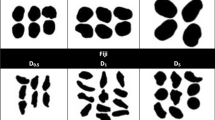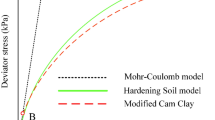Abstract
The strain softening characteristics of carbonate red clay materials will have a significant impact on the safety and economy of engineering construction. To study such stress‒strain characteristics and influencing factors, this paper takes the native carbonate red clay in Guiyang as the research object and conducts triaxial consolidated undrained tests and scanning electron microscopy under different moisture content and confining pressure conditions. The test results show that the stress‒strain curve of the native red clay in Guiyang exhibits a peak-shaped variation and that the strain softening characteristics are jointly influenced by moisture content and confining pressure. With increasing confining pressure, the consolidation time of the specimen becomes longer, and the drainage volume increases. The volume change of the specimen during shearing follows the pattern of shearing contraction and then shearing expansion. After the shear test, the pore diameter of the specimen decreases, and numerous crack-like pores appear. A double-logarithmic strain softening model is established based on the characteristic stress‒strain curves (DL model). This model includes three parameters that can be determined based on the test curve. And it is used to simulate the stress‒strain curve of the native red clay in Guiyang; the results show that the DL is a new nonlinear model that can be applied to strain-softening soils.


















Similar content being viewed by others
Data availability
The data used to support the findings of this study are available upon request from the corresponding author.
References
Bažant ZP (1976) Instability, ductility, and size effect in strain-softening concrete[J]. J Eng Mech Div 102(2):331–344
Chen XX, He P, Qin Z, Gong YP, Li JY (2019) Statistical damage model of altered granite under dry-wet cycles[J]. Symmetry 11(1):41
Chu J, Wanatowski D (2009) Effect of loading mode on strain softening and instability behavior of sand in plane-strain tests[J]. J Geotech Geoenviron Eng 135(1):108–120
Desai CS (1971) (1971) Nonlinear analyses using spline functions[J]. J Soil Mech Found Div 97(10):1461–1480
Du YJ, Wei ML, Fei J, Zhi BL (2013) Stress–strain relation and strength characteristics of cement treated zinc-contaminated clay[J]. Eng Geol 167(17):20–26
Duncan JM, Chang CY (1970) Nonlinear analysis of stress and strain in soils. J Soil Mech Found Div 96(5):1629–1653
Esrig MI (1969) Some temperature effects on soil compressibility and pore water pressure[J]. Spec Rep 231:103–022
Graham MJ (2010) Pore fluid chemistry, stress–strain behavior, and yielding in reconstituted highly plastic clay [J]. Eng Geol 116(3-4):296–310
Hu TF, Liu JK, Wang QZ, Fang JH (2018) Experimental study on the undrained shear properties of powdered clay under freeze-thaw cycles[J]. J Central South Univ (Natural Science Edition) 49(06):1481–1490
Ji YX, Zuo SY, Zhang YZ, Zhang J (2019) Modified Duncan-Chang model and mechanics parameter determination based on triaxial consolidated drained tests of Guiyang Red Clay in China[C]//new solutions for challenges in applications of new materials and geotechnical issues: Proceedings of the 5th geochina international conference 2018–civil infrastructures confronting severe weathers and climate changes: from failure to sustainability, held on July 23 to 25, 2018 in HangZhou, China. Springer International Publishing, 2019:1–17
Jia MC, Luo WS, Zhou YH, Zhang Z, Zhao S (2021) A model of undrained stress–strain curves considering stress path and strain softening[J]. Intl J Geomech 21(11):04021213
Kabwe E, Karakus M, Chanda EK (2020) Creep constitutive model considering the overstress theory with an associative viscoplastic flow rule[J]. Comput Geotech 124:103629
Kim D, Kim JR (2007) Resilient behavior of compacted subgrade soils under the repeated triaxial test[J]. Const Build Mater 21(7):1470–1479
Lee KL, Focht JR (1976) Strength of clay subjected to cyclic loading[J]. Marine Georesour Geotech 1(3):165–185
Liao YL, Zhu LJ (2004) Carbonate laterites of Guizhou[M]. Guizhou People’s Publishing House, Guizhou
Liu ZD, Lu SQ, Yang TL, Li BQ (1982) Influence of stress path on the stress-strain relationship of fill and its application[J]. Chinese J Geotech Eng 04:45–55
Liu QS, Liu DF, Tian YC, Liu XY (2017) Numerical simulation of stress-strain behavior of cemented paste backfill in triaxial compression[J]. Eng Geol 231:165–175
Munoz H, Taheri A (2019) Postpeak deformability parameters of localized and nonlocalized damage zones of rocks under cyclic loading[J]. Geotech Testing J 42(6):1663–1684
Oaths TJ, Boulanger RW (2023) Effect of Viscoplasticity on localization in saturated clays and plastic silts[J]. J Geotech Geoenviron Eng 149(4):04023016
Peng MW, Zuo SY, Yang GS, Zhang Q (2022) Experimental study on characteristics of Guiyang red clay under cyclic loading and unloading[J]. J Eng Geol 30(5):1466–1476. https://doi.org/10.13544/i.cnki.jeg.2022-0461
Qian JH, Yin ZZ (1996) Geotechnical principles and calculations[M]. China Water&Power Press, Beijing, pp 259–267
Shen ZJ (1993) Nonlinear damage mechanics model for structural clay[J]. Hydro-Sci Eng 1993(3):247–255
Taheri A, Zhang YB, Munoz H (2020) Performance of rock crack stress thresholds determination criteria and investigating strength and confining pressure effects[J]. Const Build Mater 243:118263
Tang B, Liu T, Zhou BH, Liu TL (2022) Duncan-Chang E-υ model considering the thixotropy of clay in the Zhanjiang Formation[J]. Sustainability 14(19):12258
Wang LQ, Li K, Wang Z (2022) Liu L (2022) Description and prediction of the stress-strain curve of loess[J]. Eng Geol 308:106827
Wu ZP, Xu J, Li YF, Wang SH (2022) Disturbed state concept–based model for the uniaxial strain-softening behavior of fiber-reinforced soil[J]. Intl J Geomech 22(7):04022092
Xie HP, Ju Y, Dong YL (1997) A discussion of the “modulus of elasticity method” in the definition of classical damage[J]. Mech Eng 02:2–6
Yan MQ, Yan RT, Yu HH (2021) Strain-softening characteristics of hydrate-bearing sediments and modified Duncan-Chang Model[J]. Adv Mater Sci Eng 2021:1–15
Yang GS, Zuo SY, Wu DY, Huang YT, Zhang YB, Peng MW (2021a) Experimental study on the mechanical behavior and mesoscopic damage of Guiyang red clay during triaxial loading[J]. Arab J Geosci 14:1–13
Yang GS, Zuo SY, Mo YC, Zhang YB, Li JH (2021b) NMR technology based study on pore evolution pattern of Guiyang red clay shear whole process[J]. J Eng Geol 29(5):1320–330
Yao YP (2015) Study on UH model series[J]. Chinese J Geotech Eng 37(02):193–217
Yao YP, Liu L, Wang L, Luo T (2015) Creep settlement calculation method for high fill foundations[J]. Rock and Soil Mech 36(S1):154–158
Yao YP, Liu L, Luo T, Tian Y, Zhang JM (2019) Unified hardening (UH) model for clays and sands[J]. Comput Geotech 110:326–343
Yin DS, Wu H, Cheng C, Chen YQ (2011) Chen Fractional order constitutive model of geomaterials under the condition of triaxial test[C]. Intl Des Eng Techn Conf Comput Inform Eng Conf 54808:257–265
Zhang YZ, Zuo SY, Rita YML, Mo YC, Yang GS, Zhang M (2020) Experimental study on the mechanical properties of Guiyang red clay considering the meso micro damage mechanism and stress path[J]. Sci Rep 10(1):17449
Zhang JJ, Yao BC, Ao YH, Chuang S, Jin CZ (2021) Analysis and numerical calculation of a coupled creep and strain-softening model for soft rock tunnels[J]. Plos one 16(8):e0256243
Zhang BL, Chen KS, Hu X, Zhang K (2022a) A variable-order dynamic constitutive model for clay based on the fractional calculus[J]. Appl Sci 12(13):6416
Zhang QM, Pei LH, Gui Y, Yang XY (2022b) Study on modified Duncan-Zhang model applied to strong structural clay[J]. Hydro-Sci Eng 192(02):117–125
Zhao R, Zuo SY, Sun ZQ (2018) Research of the stress-strain softening model and parameters of red clay in Guiyang[J]. Chinese J Undergr Space Eng 14(05):1258–1265
Acknowledgements
This work is supported by the National Natural Science Foundation of China (Grant No.42002280), the Science and Technology Foundation Project of Guizhou Province (ZK [2022]018), the Science and Technology Foundation of Guizhou Province ([2020]1Z052). They are gratefully acknowledged.
Author information
Authors and Affiliations
Corresponding author
Ethics declarations
Competing interests
The authors declare no competing interests.
Rights and permissions
About this article
Cite this article
Zhang, Q., Zuo, S., Wu, D. et al. Strain softening characteristics and stress–strain relationship of Guiyang carbonate laterite. Bull Eng Geol Environ 83, 121 (2024). https://doi.org/10.1007/s10064-024-03615-y
Received:
Accepted:
Published:
DOI: https://doi.org/10.1007/s10064-024-03615-y




